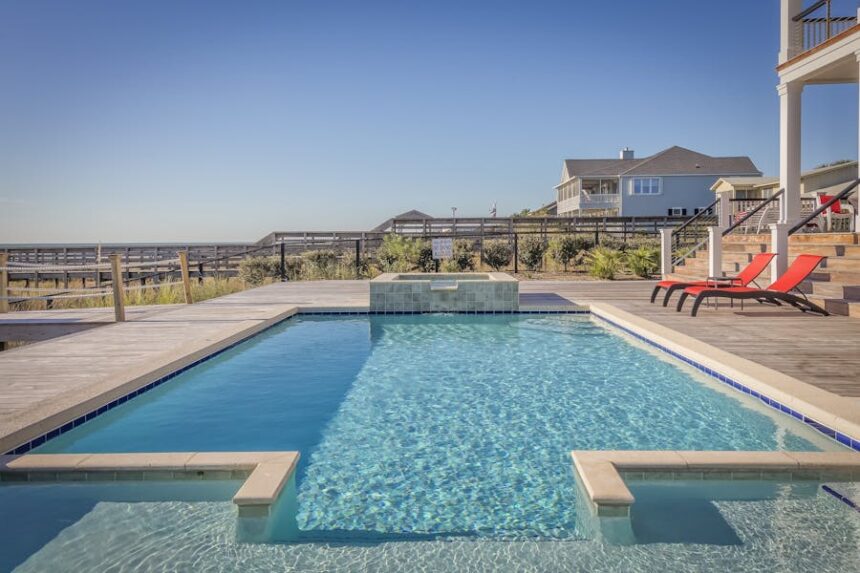When people think of pools, their minds often drift to fun summer days or backyard parties. But inground pools can offer so much more than recreation. For many homeowners, pools are becoming purposeful wellness features—designed specifically for healing, stress relief, and physical therapy. Whether you’re recovering from an injury, managing chronic pain, or simply looking to de-stress after long days, a therapeutic inground pool can be a transformative addition to your lifestyle.
Why Pools Are Ideal for Healing
Water has long been recognized for its restorative properties. It provides natural resistance without straining joints, making it ideal for low-impact movement. The buoyancy of water reduces body weight pressure, easing discomfort for those with arthritis, joint pain, or recent injuries. Warm water, in particular, helps relax muscles, improve circulation, and support physical rehabilitation. By designing your inground pool with therapy in mind, you can turn your backyard into a personal healing space.
Key Features of a Therapeutic Pool
The most effective therapeutic pools have specific design elements tailored for recovery and relaxation. First, temperature control is crucial. A heater that keeps water in the 88–94°F range can soothe sore muscles and promote relaxation. Next, consider depth variation. A shallow entry allows for gentle stretching and walking, while deeper areas support exercises like water jogging or float-assisted therapy.
Hydrotherapy jets are another important component. Strategically placed jets can massage key muscle groups, mimicking the benefits of a spa. Add-ons like built-in benches and grab rails help with balance and comfort during physical activity. These features make it easier to perform therapeutic routines and enjoy the pool even when you’re not exercising.
Incorporating a Swim Spa or Resistance Jets
Swim spas and resistance jets are game-changers for therapeutic pool design. Swim spas provide a powerful current to swim or walk against, which is great for building strength without the impact of land workouts. For smaller backyards, resistance jets can be installed in a standard pool to offer the same benefits. These systems turn your pool into a fully functional aquatic gym—perfect for building stamina, increasing flexibility, and aiding post-surgery recovery.
Integrating Nature for Mental Wellness
The healing power of a therapeutic pool isn’t limited to physical recovery. Mental well-being plays a huge role in overall health, and design choices can help foster that sense of calm. Incorporate natural elements like rock waterfalls, surrounding greenery, and soft landscape lighting. These features create a tranquil environment that encourages mindfulness and relaxation.
You might also consider saltwater systems, which are gentler on the skin and eyes than traditional chlorine. The soft, silky feel of saltwater can enhance the overall sensory experience and make your pool a true sanctuary. Add a few comfortable lounge areas nearby and you’ve got a serene space for reflection, reading, or even guided meditation sessions by the water.
Accessibility and Safety Are Key
When building a therapeutic inground pool, accessibility is just as important as aesthetics. Wide steps, handrails, and even sloped entries can make it easier for individuals with limited mobility to enter and exit the pool safely. If the pool is primarily for rehabilitation or senior use, consider installing a pool lift or zero-entry ramp.
Lighting should also be carefully planned. Soft, even lighting inside and around the pool enhances nighttime visibility without being harsh on the eyes. Motion-sensor pathway lights are a smart safety feature, especially for evening use.
Designing for Daily Use and Comfort
A therapeutic pool should be easy and inviting to use every day. That means thinking about maintenance, convenience, and comfort. Automated cleaning systems and covers can make upkeep less of a chore, so you’re more likely to enjoy the pool regularly. A shaded area, such as a pergola or canopy, offers protection from the sun during longer sessions, while outdoor speakers or calming water features can enrich the sensory experience.
For added comfort, some homeowners include adjacent hot tubs or cold plunge pools to offer contrast therapy—a method believed to speed up muscle recovery and reduce inflammation. The goal is to create a space that supports your physical and emotional wellness on a daily basis, not just once in a while.
Making Wellness Part of Your Lifestyle
A therapeutic inground pool isn’t just a luxury—it’s an investment in long-term well-being. With the right design elements and thoughtful planning, it becomes more than a backyard upgrade. It becomes a quiet refuge, a low-impact gym, and a daily escape from the pressures of modern life. Whether you’re rehabbing from an injury or simply seeking a more balanced lifestyle, a pool tailored to relaxation and recovery can make all the difference.
If you’re considering building one, talk with a pool designer experienced in wellness-focused layouts. If you are looking for ideas for inground swimming pools in Huntsville, there are companies who can help. They’ll help you craft a space that supports your goals and integrates seamlessly into your routine. After all, healing isn’t just about bouncing back—it’s about creating a life that feels good every day.




